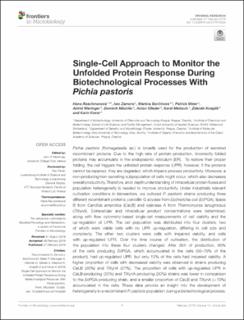Please use this identifier to cite or link to this item:
https://doi.org/10.21256/zhaw-19480Full metadata record
| DC Field | Value | Language |
|---|---|---|
| dc.contributor.author | Raschmanová, Hana | - |
| dc.contributor.author | Zamora, Iwo | - |
| dc.contributor.author | Borčinová, Martina | - |
| dc.contributor.author | Meier, Patrick | - |
| dc.contributor.author | Weninger, Astrid | - |
| dc.contributor.author | Mächler, Dominik | - |
| dc.contributor.author | Glieder, Anton | - |
| dc.contributor.author | Melzoch, Karel | - |
| dc.contributor.author | Knejzlík, Zdeněk | - |
| dc.contributor.author | Kovar, Karin | - |
| dc.date.accessioned | 2020-02-19T14:14:53Z | - |
| dc.date.available | 2020-02-19T14:14:53Z | - |
| dc.date.issued | 2019 | - |
| dc.identifier.issn | 1664-302X | de_CH |
| dc.identifier.uri | https://digitalcollection.zhaw.ch/handle/11475/19480 | - |
| dc.description.abstract | Pichia pastoris (Komagataella sp.) is broadly used for the production of secreted recombinant proteins. Due to the high rate of protein production, incorrectly folded proteins may accumulate in the endoplasmic reticulum (ER). To restore their proper folding, the cell triggers the unfolded protein response (UPR); however, if the proteins cannot be repaired, they are degraded, which impairs process productivity. Moreover, a non-producing/non-secreting subpopulation of cells might occur, which also decreases overall productivity. Therefore, an in depth understanding of intracellular protein fluxes and population heterogeneity is needed to improve productivity. Under industrially relevant cultivation conditions in bioreactors, we cultured P. pastoris strains producing three different recombinant proteins: penicillin G acylase from Escherichia coli (EcPGA), lipase B from Candida antarctica (CaLB) and xylanase A from Thermomyces lanuginosus (TlXynA). Extracellular and intracellular product concentrations were determined, along with flow cytometry-based single-cell measurements of cell viability and the up-regulation of UPR. The cell population was distributed into four clusters, two of which were viable cells with no UPR up-regulation, differing in cell size and complexity. The other two clusters were cells with impaired viability, and cells with up-regulated UPR. Over the time course of cultivation, the distribution of the population into these four clusters changed. After 30 h of production, 60% of the cells producing EcPGA, which accumulated in the cells (50-70% of the product), had up-regulated UPR, but only 13% of the cells had impaired viability. A higher proportion of cells with decreased viability was observed in strains producing CaLB (20%) and TlXynA (27%). The proportion of cells with up-regulated UPR in CaLB-producing (35%) and TlXynA-producing (30%) strains was lower in comparison to the EcPGA-producing strain, and a smaller proportion of CaLB and TlXynA (<10%) accumulated in the cells. These data provide an insight into the development of heterogeneity in a recombinant P. pastoris population during a biotechnological process. A deeper understanding of the relationship between protein production/secretion and the regulation of the UPR might be utilized in bioprocess control and optimization with respect to secretion and population heterogeneity. | de_CH |
| dc.language.iso | en | de_CH |
| dc.publisher | Frontiers Research Foundation | de_CH |
| dc.relation.ispartof | Frontiers in Microbiology | de_CH |
| dc.rights | https://creativecommons.org/licenses/by/4.0/ | de_CH |
| dc.subject | Pichia pastoris | de_CH |
| dc.subject | Fed-batch culture | de_CH |
| dc.subject | Flow cytometry | de_CH |
| dc.subject | Heterogeneity | de_CH |
| dc.subject | Single-cell | de_CH |
| dc.subject | Stress response | de_CH |
| dc.subject | Super folder green fluorescent protein (sfGFP) | de_CH |
| dc.subject | Unfolded protein response (UPR) | de_CH |
| dc.subject.ddc | 660.6: Biotechnologie | de_CH |
| dc.title | Single-cell approach to monitor the unfolded protein response during biotechnological processes with pichia pastoris | de_CH |
| dc.type | Beitrag in wissenschaftlicher Zeitschrift | de_CH |
| dcterms.type | Text | de_CH |
| zhaw.departement | Life Sciences und Facility Management | de_CH |
| dc.identifier.doi | 10.3389/fmicb.2019.00335 | de_CH |
| dc.identifier.doi | 10.21256/zhaw-19480 | - |
| dc.identifier.pmid | 30873140 | de_CH |
| zhaw.funding.eu | No | de_CH |
| zhaw.issue | 335 | de_CH |
| zhaw.originated.zhaw | Yes | de_CH |
| zhaw.publication.status | publishedVersion | de_CH |
| zhaw.volume | 10 | de_CH |
| zhaw.publication.review | Open peer review | de_CH |
| zhaw.author.additional | No | de_CH |
| Appears in collections: | Publikationen Life Sciences und Facility Management | |
Files in This Item:
| File | Description | Size | Format | |
|---|---|---|---|---|
| 2019_Raschmanova_Single-cell.pdf | 3.05 MB | Adobe PDF |  View/Open |
Show simple item record
Raschmanová, H., Zamora, I., Borčinová, M., Meier, P., Weninger, A., Mächler, D., Glieder, A., Melzoch, K., Knejzlík, Z., & Kovar, K. (2019). Single-cell approach to monitor the unfolded protein response during biotechnological processes with pichia pastoris. Frontiers in Microbiology, 10(335). https://doi.org/10.3389/fmicb.2019.00335
Raschmanová, H. et al. (2019) ‘Single-cell approach to monitor the unfolded protein response during biotechnological processes with pichia pastoris’, Frontiers in Microbiology, 10(335). Available at: https://doi.org/10.3389/fmicb.2019.00335.
H. Raschmanová et al., “Single-cell approach to monitor the unfolded protein response during biotechnological processes with pichia pastoris,” Frontiers in Microbiology, vol. 10, no. 335, 2019, doi: 10.3389/fmicb.2019.00335.
RASCHMANOVÁ, Hana, Iwo ZAMORA, Martina BORČINOVÁ, Patrick MEIER, Astrid WENINGER, Dominik MÄCHLER, Anton GLIEDER, Karel MELZOCH, Zdeněk KNEJZLÍK und Karin KOVAR, 2019. Single-cell approach to monitor the unfolded protein response during biotechnological processes with pichia pastoris. Frontiers in Microbiology. 2019. Bd. 10, Nr. 335. DOI 10.3389/fmicb.2019.00335
Raschmanová, Hana, Iwo Zamora, Martina Borčinová, Patrick Meier, Astrid Weninger, Dominik Mächler, Anton Glieder, Karel Melzoch, Zdeněk Knejzlík, and Karin Kovar. 2019. “Single-Cell Approach to Monitor the Unfolded Protein Response during Biotechnological Processes with Pichia Pastoris.” Frontiers in Microbiology 10 (335). https://doi.org/10.3389/fmicb.2019.00335.
Raschmanová, Hana, et al. “Single-Cell Approach to Monitor the Unfolded Protein Response during Biotechnological Processes with Pichia Pastoris.” Frontiers in Microbiology, vol. 10, no. 335, 2019, https://doi.org/10.3389/fmicb.2019.00335.
Items in DSpace are protected by copyright, with all rights reserved, unless otherwise indicated.